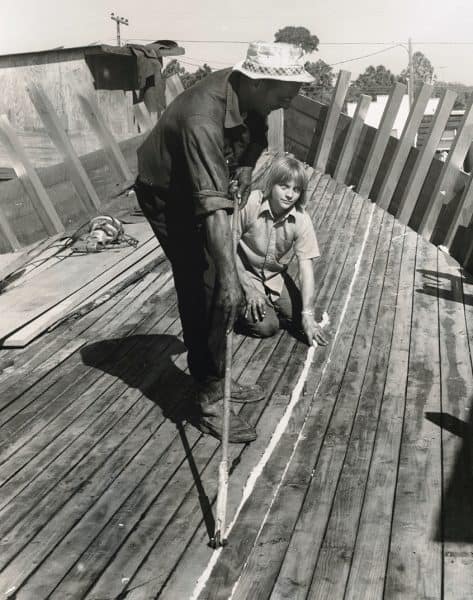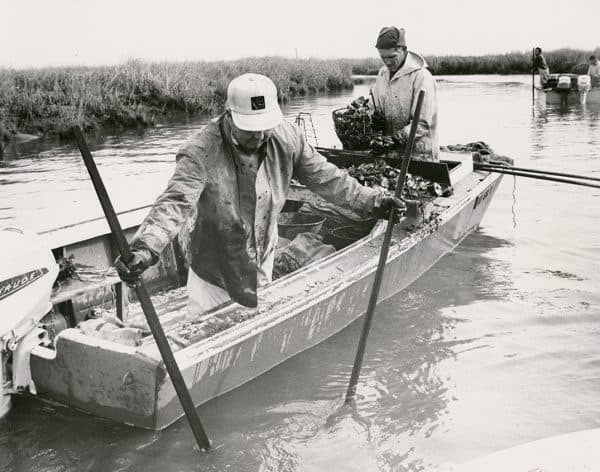Email This Page to a FriendVoyaging Thru Time: Photographs from Penobscot Marine Museum, Part 8
January 9, 2018
Here is another batch from our National Fisherman collection of historic photographs. Enjoy!
Kevin Johnson, Photo Archivist, Penobscot Marine Museum


MEDEA in the Slings. Being lifted by slings is nothing new to this handsome, Scottish-built 120-foot Edwardian steam yacht. She was hoisted aboard the German freighter REIDERSTEIN in Rotterdam, then lifted off by a floating crane after she arrived at Long Beach in 1973. While at Long Beach she had her bottom sheathed in epoxy, Airex, and fiberglass. She then was slung overboard, bound for the San Diego Maritime Museum to became a floating exhibit. She occasionally puts to sea under her two-cylinder steam engine and periodically gets lifted by the slings of a big Travelift. (LB2012.15.2849 from National Fisherman, February, 1991, page 46)

Dragger on Railway. Built and fished originally in Rhode Island and Connecticut, Western-rigged draggers like ANGELINE had their wheelhouses over the engine and forward of the the fish hold. (Larger versions, with their wheelhouses aft, fished offshore and were called Eastern-rigged draggers.) This vessel, built in 1926 and now named OLD PILGRIM, was still around in 2017—but in North Carolina, and in rough condition. (LB2012.15.2870 from the 1990 National Fisherman Yearbook, page 72)

Shrimper on Railway. Before big marine Travelifts came into use, marine railways did the work of hauling out vessels for painting and repair. Chances are that this photo is in Florida, Georgia or the Carolinas where big wooden shrimpers were built and used. (LB2012.15.2432)

Retopping Afloat, New Bedford, MA. The RODERICK’s rail, or bulwark, that surrounds her working deck has worn out from heavy use and weathering, so the time has come to renew it. It’s more convenient and surely far less expensive to re-top her from a floating stage than to haul her out on a railway. Here, the workers have the vessel’s rail stanchions, her planking and her covering boards, at just the right height. (LB2012.15.2797 from National Fisherman, March, 1966, page 22)

Spring Painting, 1978, at Everett, WA. A float also works perfectly fine, even for paining topsides. (LB2012.15.1787 from 1979 National Fisherman photo contest)

Renewing the Transom. To keep the hull from distorting while this lobsterboat’s transom is out of her, Ray Jones uses an external mold propped up from the ground. Using a cobbled-together trailer, overhead costs were kept low at Windy Hollow Boatyard in East Friendship, ME. (LB2012.15.2967 from National Fisherman, July, 1975)

Caulking the Deck. To save his knees, this man has lengthened the handle of his caulking wheel. Kneeling doesn’t trouble his helper, however, who likely is thinking about someday taking over the job at this Provincetown, MA, yard. (LB2012.15.1672)

Tonging for Oysters. Despite their small size, outboard boats like this garvey are perfectly fine for working in sheltered creeks of the Chesapeake where the water is thin. (LB2012.15.1542)

Buy Boat, Converted. MILDRED BELLE and others of her type make dandy conversions for carrying passengers for hire or for recreational use. This one carries 46 passengers—a far cry from the thousands of oysters that once loaded her deck. (LB2012.15.1751 Chesapeake Bay Maritime Museum photo from National Fisherman, September, 1993, page 35)

Dredging for Clams off Ocean City, MD. Using a water hose in combination with a conveyor belt, this so-called hydraulic escalator dredge exposes and raises soft shell clams from the bottom and deposits them aboard LAST CHANCE as she moves slowly ahead. (LB2012.15.1449 from National Fisherman, March, 1968, page 5-C.)

A Good Harvest. These Maryland waters are too deep for manual digging so a dredge brings up the clams to MISS RENEE where they’re loaded into baskets. The fishery is now in remission due to storms and disease, dropping from 460,000 bushels per year to the present 4,000. (LB2012.15.1446 from National Fisherman, May, 1970, page 21-B)

Trawler ST. GEORGE. Called draggers if they’re smaller than this 110-footer, all vessels of this type towed their nets and landed their fish over the side instead of over the stern as has evolved more recently. This vessel is rigged to fish from either side so the fishing isn’t interrupted when a net has to be repaired. (LB2012.15.1343 from Maine Coast Fisherman)

The Cod End. The small end of the funnel-shaped net where the fish get clustered is called the cod end. Here, on this un-named Canadian dragger, the trip line is about to be pulled. The cod end then opens and the fish spill onto the deck where they’re sorted into pens before they’re sent below for icing. (LB2012.15.1187)

Icing Down. A dragger’s fish hold is divided like an ice cube tray. Horizontal pen boards slide into grooved stanchions and gradually build up the height. Alternate layers of fish and chipped ice preserve the catch until it’s unloaded. Salt instead of ice preserved the fish in earlier times, but required that the fish be cleaned, rather than landed fresh. (LB2012.15.2885)

Building SHENANDOAH. Based on the revenue cutter JOE LANE of the mid-19th century, this 108′ engineless topsail schooner was designed by her owner and launched from the South Bristol, ME, yard of Harvey Gamage in 1964. Over a half-century later, in 2017, she was still sailing from the same home port (Martha’s Vineyard, MA) under the same owner (Capt. Robert S. Douglas). [LB2012.15.2868]
Continue to Part 9
In 2012, Diversified Communications of Portland, ME, donated National Fisherman magazine’s entire pre-digital photographic archive to the Penobscot Marine Museum (PMM). Although the Museum has Fair Use rights to the images, responsibility for determining the nature of copyright and obtaining permissions to publish, transmit or reproduce these materials rests entirely with the researcher. You can view many more photos of this collection here.
4 Responses So Far to “Voyaging Thru Time: Photographs from Penobscot Marine Museum, Part 8”:


I am finally finding time to look at these great historic photos. The picture of re-planking the topsides of the Manuel F. Roderick was particularly interesting as I hired on to chop out mortices to fit the cap rail over the top timbers about a week after this picture was taken.
The boat is tied up at Kelly’s shipyard although the crew pictured is from Fairhaven marine next door. After the port side was finished, she was pulled in to the wharf and we started on the starboard side. I spent many hours swinging a top maul while the shipwright who new what he was doing held the hawsing iron and set the oakum.
This all makes me feel like a historical artifact.
Great, great photos! And wonderful captions! More, please!
Didn’t know the nomenclature of draggers and trawlers. Thanks!
These photos are magnificent.Thanks.